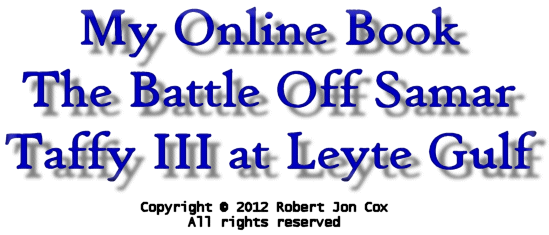
COMMENTS ARE ENABLED ON THE BOTTOM OF THE PAGE
Chapter 8
0730 to 0800
SMALL BOYS SCREENING ACTION
Wednesday, October 25, 1944
|
Time-Line, Events, & Comments
|
|
0730 The leading escort carriers of Taffy III exit the squall in a circular formation with ST LO the furthest north, closest to the Japanese, base course 190° T. Ahead and to her port quarter are KALININ BAY and GAMBIER BAY. Furthest to the south is KITKUN BAY. Ahead and on ST LO's starboard quarter bow are flagship FANSHAW BAY and WHITE PLAINS. A/C As the enemy had continued to close and to come up on the northward side, the Task Unit Commander changed course to the right, in two or more increments, to 180° T at about 0730 and a little later to 240° T, to avoid remaining for long periods on a steady course. 0730 Upon exiting the rain squall, RADM Sprague radios an urgent message to VADM Kinkaid, Commander Seventh Fleet, requesting permission to move his fleeing escort carrier force toward the safety of Seventh Fleet's battleships and cruisers near the Leyte Gulf invasion beach. Vice Admiral Kinkaid’s answer is "NO." |
VADM Thomas Kinkaid, USN "The CVEs were being driven south by the Japanese cruisers. I had a dispatch from (RADM) Sprague asking for permission to enter Leyte Gulf. I sent back a negative reply. To enter Leyte Gulf meant that they would be in confined waters. They'd be easy marks for Jap air, and if they got as far as the entrance of Leyte Gulf, he would be joined by my surface ships for cover. The message I sent to (RADM) Oldendorf, as soon as I had the report of our CVEs under fire, was to assemble all of his ships at the northern part of the entrance to Leyte Gulf, get them all there as quickly as possible. That was followed a little bit later by an order to divide his ships into two groups, and to send one group outside to buoy...a marker buoy to our entrance to Leyte Gulf. I didn’t want to send those ships outside of Leyte Gulf, although at the time the CVEs were in dire need...but I couldn’t let them be hammered to pieces without doing anything, so I gave these preliminary orders." |
A/C By saying no, VADM Kinkaid let RADM Sprague know he considered Taffy III expendable. It had been said that Seventh Fleet's old battleship and cruiser forces near the southern approaches to Leyte Gulf were now low on ammunition after having just defeated the Japanese Southern Force in the Battle of Surigao Strait earlier that morning. It is arguable just how low in ammunition they were.... Vice Admiral Kinkaid, a resolute commander who was always in control, would choose where and when his fleet would fight.
A/C Seventh Fleet was in poor position to support Taffy III at this time; the reasons being many. Although their performance against the Japanese Southern Force was an unqualified success, they were hardly a match for a fleet the size and strength of Centre Force. Vice Admiral Kinkaid knew the possibility now existed that Centre Force may make it all the way to Leyte Gulf intact. What was worse, coming to grips with the realization that Third Fleet had abandoned him, he now had to prepare for the unplanned contingency of fighting a force he never should have fought!?
A/C The only Seventh Fleet unit currently in a position to help RADM Sprague was Taffy II, and they themselves were dangerously close to Centre Force.
|
A/C This placed VADM Kinkaid in a dilemma. Totally misled by ADM Halsey’s earlier battle plan communication, Commander Seventh Fleet had to plan for the worst. A/C During the Battle of Surigao Strait, RADM Oldendorf’s battleships and cruisers had expended most of their armor piercing-ammunition. If Centre Force’s "heavily" armored ships proceeded to Leyte Gulf in their present formation of four battleships, six to eight cruisers, and their destroyers, Seventh Fleet would require a significant amount of armor-piercing ammunition in order to stop them. Adding to this crisis was the fact that the slow battleships were not fully loaded with armor-piercing ammunition from the start of the Leyte operation, since their main objective was to provide shore bombardment. A/C When RADM Oldendorf’s old battleships arrived at Leyte Gulf, only one-fifth of their ammunition on board was armor-piercing. Previously at Yap, they had been loaded with high-capacity shells to support their scheduled shore bombardment duties. |
LTJG Joseph A. Mamica, USNR Damage Control Officer USS JOHN C. BUTLER (DE-339)
Not long after that I heard the bombardment of the guns, shouting of orders, and felt the erratic movement of the ship as the Captain took evasive maneuvers to avoid the bombs. Near misses grazed the BUTLER on the sides. I felt the concussion on my body. Admiral Sprague gave orders for ‘torpedo strikes.’ Our sister ships, RAYMOND and DENNIS, made the torpedo attacks. We were the next to go, but at the last moment Admiral Sprague changed the order, ‘to make smoke’ and hide the ships that were damaged." |
Earlier during the Leyte operation, they had expended over one-half of their high-capacity shells fulfilling these duties, including some of their armor-piercing shells on some of the harder targets found ashore.
A/C The American heavy cruisers at Surigao Strait loaded two-thirds of their ammunition in high-capacity shells, the remaining third was armor-piercing. During their engagement with VADM Nishimura’s Southern Force Van, they had almost wastefully used about eighty percent of their load. At the end of the fighting the light cruisers did however, still carry about 50-80 armor-piercing shells apiece.
A/C The destroyers of Seventh Fleet were in a much more desperate state of affairs. During the Battle of Surigao Strait they had expended all, if not most of their torpedoes. As with the armor-piercing shells, no torpedo replacements were readily available. If matters were not grave enough, at this point, all of the ships were low in fuel. October 25 was their scheduled replenishment day.
A/C In his Action Report of November 18, 1944, VADM Thomas Kinkaid, CTF 77, stated:
At about 0730, in response to orders to cover a retirement of the northern carrier task unit, two destroyers - HOEL and JOHNSTON - and the ROBERTS (DE) reversed and delivered a daylight half salvo torpedo attack against the enemy battleships at a range under 10,000 yards, then turned and delivered the other half salvo against enemy heavy cruisers at a range of 7,000 yards. After one of the most gallant and heroic acts of the war, all three ships were sunk, although the HOEL continued to withstand concentrated enemy fire for about one hour before finally sinking. As a result of continuing air action by our CVEs and the destroyer attack, the enemy momentarily turned away, and several of his ships were seen to be hit and in trouble.
0730 After careful evaluation of the tactical situation, VADM Kurita orders the fast heavy cruisers of Centre Force to pursue the Americans at top speed on course 110° T.
A/C Vice Admiral Kurita feared the American carriers were getting away and would soon be out of reach. The rain squall and highly effective smoke screen was hindering the Japanese effort.
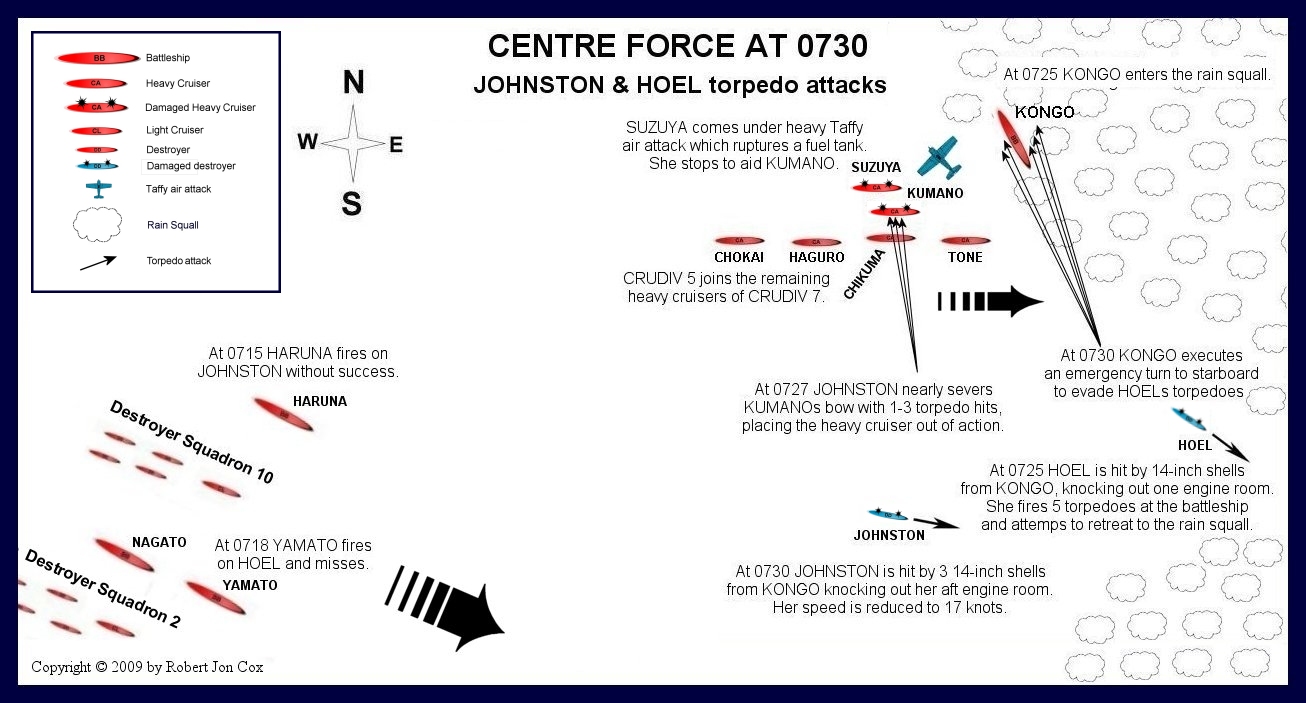
0730 From the port quarter, the escort carriers are sighted once again as they exit the rain squall. They immediately come under heavy concentrated fire from heavy cruisers TONE, CHIKUMA, HAGURO, and CHŌKAI who attempt to outflank the escort carriers to port. Multi-colored shells once again fall among the ships of Taffy III.
A/C With KUMANO and SUZUYA of Cruiser Division Seven out of action, the two remaining heavy cruisers, TONE and CHIKUMA, were joined by Cruiser Division Five’s two ships, HAGURO and CHŌKAI. The threat to Taffy III is now greater than ever as the two heavy cruiser divisions coordinate their attack and rapidly close the escort carriers from their port quarter.
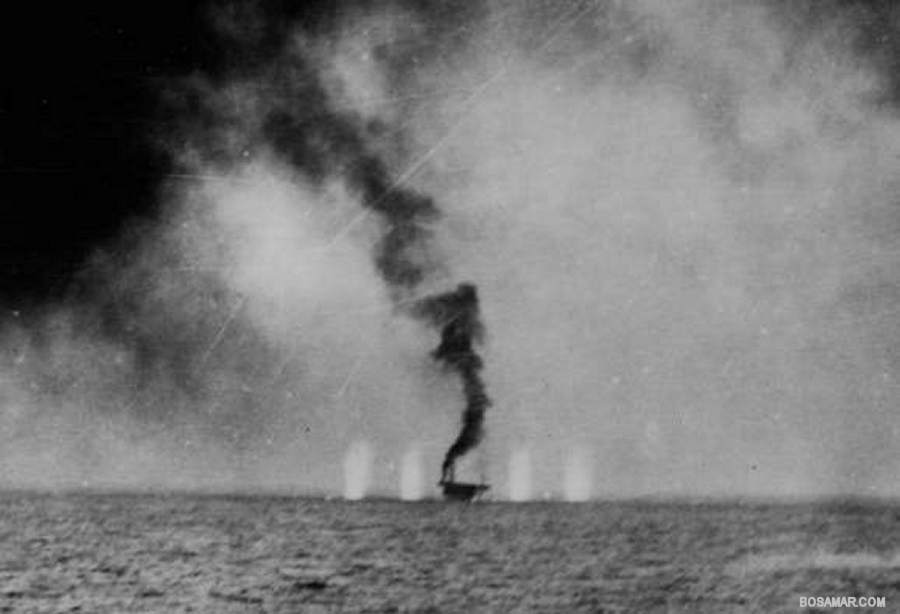
U.S. Navy Photograph
Escort Carrier USS GAMBIER BAY (CVE 73) is straddled by salvos
|
EVENT Escort carrier GAMBIER BAY, on the rear-port quarter, comes under intense shell fire from the approaching heavy cruisers. A/C The picture at this point in the battle looked bleak for the Americans. The four heavy cruisers were quickly approaching the escort carriers from their port quarter. They were now closing to within optimum range for their 8-inch guns. On the starboard quarter, Destroyer Squadron Two, led by the light cruiser NOSHIRO was in position to limit Taffy III’s maneuvering space to a southern direction only. Finally, from the rear, the four battleships came down the middle adding their heavy guns to the free-for-all. Rear Admiral Sprague’s options were very limited. He had to sacrifice his screening ships to save the escort carriers. |
CAPT Walter V. R. Vieweg, USN Commanding Officer USS GAMBIER BAY (CVE-73)
|
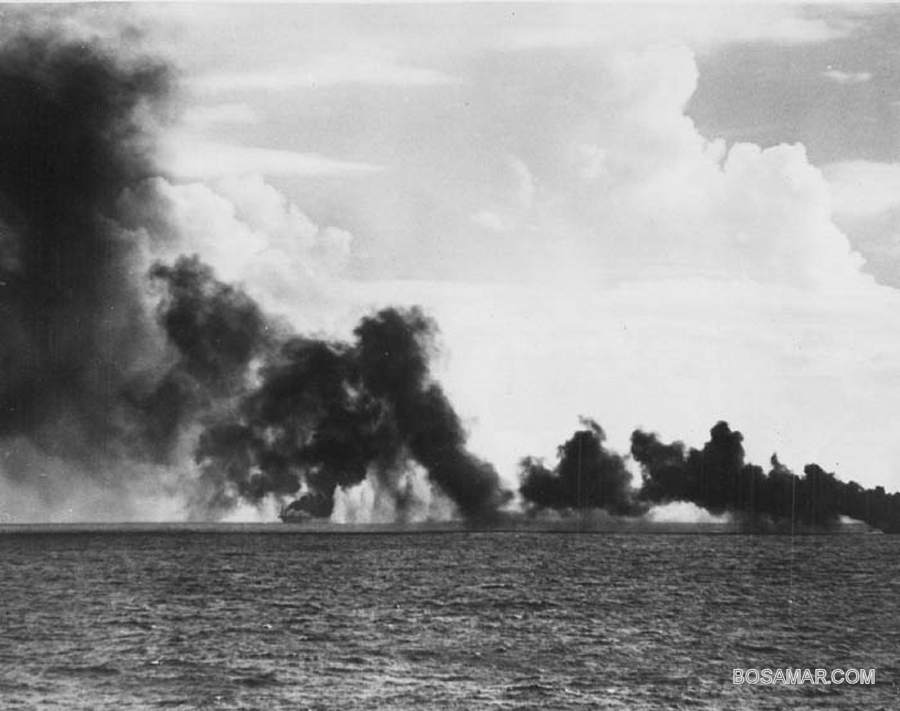
U.S. Navy Photograph
USS GAMBIER BAY (CVE 73) under fire
EVENT Under increasingly heavy near-misses, CVE GAMBIER BAY resorts to chasing salvos to avoid being hit.
A/C "Chasing salvos" consisted of turning the ship toward the last shell splash, in hope that Japanese fire control would try to correct their aim and shoot in a different direction to correct their aim. This technique kept GAMBIER BAY from under the heavy guns for over half an hour.
EVENT Japanese Destroyer Squadron Two, led by the CL NOSHIRO approaches the escort carriers from their starboard quarter in an attempt to block their escape toward Leyte Gulf.
A/C Nearly forty-five minutes have passed since the Japanese first charged the escort carriers. Rear Admiral Sprague's constant course changes and dense smoke screen were buying time and aided in keeping the distance between his fleeing carriers and the pursuing warships.
A/C In addition to RADM Sprague's grace-saving efforts, the Japanese helped by not cutting corners on their approach. Instead, they concentrated on cutting off the task unit’s escape to open ocean by boxing it in on three sides. However, this is not to say the Japanese were not closing the escort carriers; they were!
| EVENT The two Japanese destroyer squadrons, originally ordered to bring up the rear, are now utilized to work the starboard flank of the escort carriers in an attempting to box them in and drive them back towards the battleships’ big guns. 0732 The escort carriers are ordered to course 170° T to help keep their distance from the heavy cruisers approaching on their port quarter. Rear Admiral Sprague orders all airborne aircraft to concentrate on the heavy cruiser column. Heavy cruisers CHIKUMA, TONE, HAGURO, and CHŌKAI press on in an attempt to cut off the escort carriers’ retreat. 0732 TBS - Taffy 2 v GALLEY, "I HAVE FOUR FISH LOADED WITH TORPEDOES AND FOUR FIGHTERS READY TO GO WHEN READY." .... v Taffy 2, "ROGER OUT." A/C An escort carrier of Task Unit 77.4.2 (Taffy II) reports is has four TBM torpedo bombers and four FM-2 fighters ready for launch. 0733 TBS - Taffy 3 v CATNIP, "WILL LAUNCH ONE FISH WITH A FISH IN IT IN ABOUT ONE MINUTE." A/C "FISH" was the radio codename for an Avenger torpedo bomber....the second "FISH" refers to a torpedo. |
LT H. Burt Bassett, USNR Just as we deployed for attack I noticed a great deal of AA which was apparently directed at someone who preceded us. I swung to the Skipper’s port side, interval about 100 yards just prior to his signal for attack. I lost sight of other planes at that time. We seemed to be approaching a column of cruisers from the south-their course being easterly. As the Skipper dove to the left, heading for the second ship in column, he instructed me to take the one on the right which was in the lead. It was a MOGAMI class. I pulled up to about 2800’ as the distance closed and as I nosed over from the cloud base, I realized that the AA was becoming very intense. My run was from slightly abaft the starboard beam of the cruiser. The dive was approximately 35 degrees. Almost simultaneous with the release of my first bomb at 2000’, the plane shuddered from a hit and I released the second bomb at once-pulling out at 1500’ at about 200 knots, and within about 20 seconds I was able to get into the clouds ahead of the cruiser. |
0733 From the escort carrier ST LO, the Japanese force bears 275° T, 19,500 yards, and closing.
0733 Crossing astern of BB NAGATO, IJN BB HARUNA fires on a "cruiser" as it reveals itself from behind the smoke.
0734 TBS - Taffy 3 v BRASSLOCK, "HAS CONTACT REPORT BEEN MADE, OVER."
A/C Inquiry from JOHNSTON.
0735 TBS - v Taffy 3, "OPEN UP WITH PEASHOOTER ON STERN."
A/C When the nearest Japanese warship had closed to 23,000 yards, an order to open up with the 5"/38 GP guns on the stern of the escort carriers was given, "when within range."
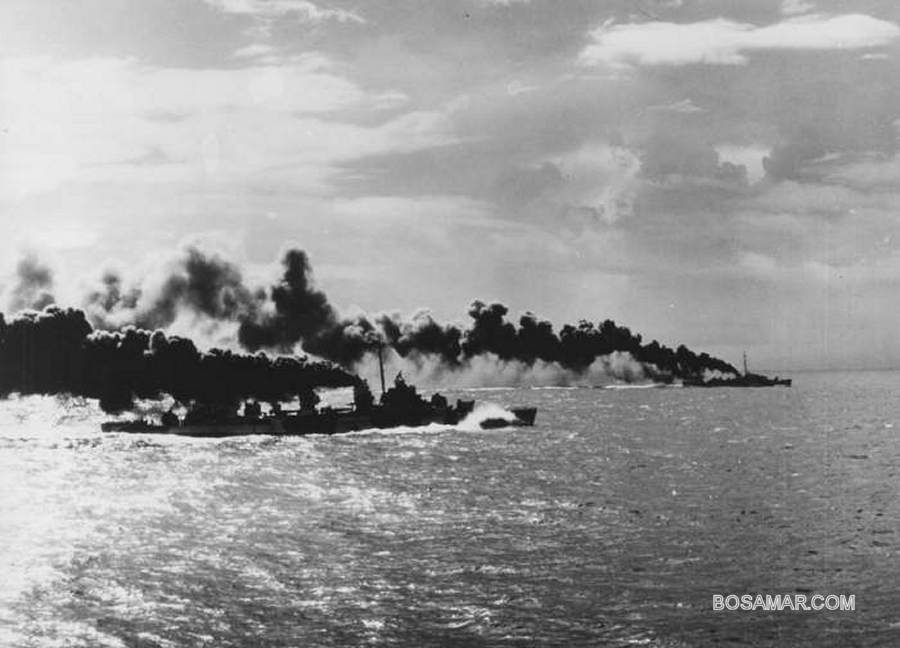
U.S. Navy Photograph
The escorts of Task Unit 77.4.3 lay protective smoke
0735 TBS - Taffy 33 v Taffy 3, "DELIVER FISH ATTACK, OVER." .... v Taffy 33, "WILCO OUT."
0735 Maneuvering at full speed, about 22 knots, DENNIS is positioned at 270° T on the task unit formation, between the CVEs and the advancing enemy warships.
0735 Between 0735 and 0740 DE RAYMOND reports a torpedo wake observed to be approaching and passing the vessel approximately 20 yards to port. RAYMOND continues to make white chemical FM and black funnel smoke.
0736 TBS - Mercury 3 v Taffy 3, "ALL GREAT DANES STANDBY TO OPEN UP WITH YOUR GUNS WHEN RANGE IS CLEAR."
A/C At this point the nearest Japanese warships were closing on the escort carriers (Great Danes), but were still out of range of the CVEs single 5-inch guns. The gun crews were ordered to prepare or "STANDBY" to open fire when the enemy warships were with in the effective range ("WHEN RANGE IS CLEAR") of their 5-inch guns.
0736 TBS - OVERTURE v Taffy 3, "ARE YOUR TORPEDOES READY, OVER?"
0736 TBS - MONGREL v Taffy 3, "ARE YOUR TORPEDOES READY, OVER?" .... v MONGREL, "AFFIRMATIVE."
| 0736 TBS - Taffy 33 v JUGGERNAUGHT, "DO YOU WANT LITTLE FELLOWS TO GO IN WITH BIG, OVER."
0737 TBS - Mercury 33 v Taffy 33, "BIG FELLOWS MAKE FIRST RUN, FORM ON ME IN ORDER, DREADNAUGHT, NEBRASKA, BRASSLOCK. LITTLE FELLOWS FORM UP FOR SECOND RUN. BRASSLOCK, JUGGERNAUGHT, WILCO OUT." A/C The closest Japanese warships were now bearing 302° T, 14,000 yards. Many salvo splashes were noted throughout the formation. All ships were making maximum smoke and all the CVEs were firing their single 5-inch guns. The ST LO singled out a heavy cruiser at 14,000 yards astern, closing, apparently not under fire from any other CVE. Three hits were claimed, one forward of the forward turret starting a fire, and two between the bridge and the first stack. Escort Carrier ST LO’s Action Report stated, "...a CA (heavy cruiser) accompanied by a large destroyer had moved up on the port beam of our formation at an initial range of 16,000 yards which later closed to 12,000 yards and fired very deliberately full broadsides at the ships of the formation." |
LCDR Robert W. Copeland, USNR Commanding Officer USS SAMUEL B. ROBERTS (DE-413)
My Executive Officer was down in CIC and I just took a look at the general situation and where the cruiser column was and estimated the course to put me sixty degrees on the bow of the cruiser column....by seaman's eye I estimated my course change to the left to bring me to what I estimated the course would be and at the same time I reached over and grabbed the handle on the squawk box....I said "Well, Sis on you, pister. Let's go!" and added, "...give me a course to put me sixty degrees on the bow of the leading ship in that cruiser column...." In less than thirty seconds I was given a course that was bout six degrees to the left of the one I had picked....I came to it and we were on our way and committed to go in on a torpedo attack...." |
0737 The escort carriers of Taffy II are turned into the wind on course 025° T and begin launching their first air strike.
0738 Sighted from DE DENNIS, enemy shell fire is seen to fall 1,000 yards astern of the carrier group, in sustained fire.
0738 Destroyer Escort BUTLER exits the rain squall.
0740 As visibility permits, DE DENNIS opens fire with her two 5-inch guns on enemy cruisers and destroyers. The opening range is 15,200 yards.
A/C Aboard DENNIS, Lieutenant Commander Hansen heard RADM Sprague’s order to the destroyers to make the torpedo attack. As senior destroyer escort CO, he assumed he would lead the other DEs in their attack and tried to locate the other DEs visually to no avail. The entire area was heavily covered by smoke and rain squalls making visibility very difficult.
|
0740 Far to the south RADM Thomas Sprague's Task Unit 77.4.1 (Taffy I) is attacked without warning by four single-engine Japanese aircraft, believed to be a Zekes or Judys. These aircraft attempt to make suicide dives on each of the four escort carriers located at position Latitude 09°-49' North to Longitude 126°-43' East. A Zeke 52 crashes on CVE SANTEE's deck forward of the aft elevator causing a fire on both flight and hangar decks. A burning plane is jettisoned over the side. At the same time CVE's SANGAMON and PETROF BAY are each attacked by a suicide plane, all of which were believed to be hit by anti-aircraft fire from the ships. The fourth plane leaves the area. A/C The damage to SANTEE had the potential of being very serious as fires were started on the hangar deck where depth and SAP bombs were lying on the deck. Due to quick action by damage control parties the fires were extinguished before they had gotten out of hand. The personnel casualties, however, were very serious. Twenty-seven men were wounded and sixteen were killed in the attack. SUWANEE, SANGAMON and PETROF BAY all faired much better with no loss of men or material. Very heavy anti-aircraft from all ships had done their job well. |
TASK UNIT 77.4.1 (Taffy I) Escort Carriers Destroyers Destroyer Escorts |
0742 Rear Admiral Sprague urgently orders the "small boys" (destroyers) to form up and make another torpedo attack on the menacing Japanese heavy cruisers. Destroyer HOEL, although badly damaged by her encounter with BB KONGŌ, leads, closely followed by newly arrived DD HEERMANN, the only undamaged destroyer remaining. At this time DE BUTLER is laying a smoke screen on the starboard beam of the CVE formation and had just come about to run astern and renew the smoke screen. LCDR Pace orders, "PREPARE TO MAKE TORPEDO ATTACK" and turns the ship slightly to port to join up with the three destroyers.
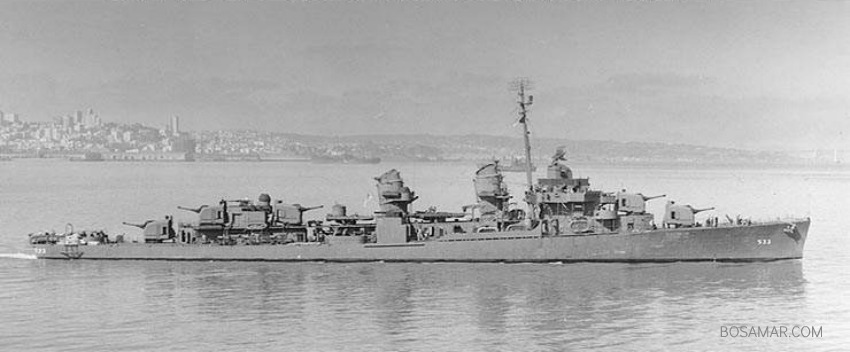
U.S. Navy Photograph
Destroyer USS HOEL (DD-533) in San Francisco Bay, August 7, 1943
EVENT Destroyer HEERMANN, on the south side of the task unit, furthest from the action, turns north to engage the cruiser line and races through the CVE formation among the multi-colored shell splashes which continued to fall among the escort carriers. Destroyer HEERMANN, able to make better than 30 knots, speeds through the smoke screen and nearly collides with DE ROBERTS, which is laying smoke between the escort carriers and the Japanese cruiser column.
A/C The three destroyers of Taffy III were faced with an overwhelming responsibility this day. They were practically all that stood between the escort carriers and VADM Kurita’s Centre Force. They fought so magnificently, It is no wonder the Japanese had called them "cruisers" in their action reports.
A/C Quoting CVE KITKUN BAY's Ship's History, "it was an inspiring sight to see those small, inadequately armed vessels turn without hesitation to attack so overwhelming a force, which by now had been determined as consisting of six (actually 4) battleships, seven (actually 6) heavy cruisers, three (actually 2) light cruisers, and ten (actually 11) destroyers...".
EVENT In response to hearing the order for torpedo attack, LCDR Copeland aboard DE ROBERTS calls Screen Command CDR Thomas via TBS and asks if DEs were to accompany the destroyers. DE ROBERTS was told, "...the Little Wolves will join up for second attack...."
A/C "Little Wolves" was the TBS codeword for the destroyer escorts of Taffy III. At this point in the battle, DE ROBERTS was on the engaged port side of the escort carrier formation with none of her sister DEs to be found. Lieutenant Commander Copeland had in fact waited to see if any of the other DEs were responding to the order to form a second attack. The senior destroyer escort present was DENNIS. When it appeared no other DEs would reply, he followed the last destroyer at 3,000 yards astern when it sped past him. Destroyer escorts, lightly armed, were not trained in group torpedo attack tactics, their soul purpose being anti-submarine warfare.
0743 Destroyer Escort RAYMOND hears RADM Sprague's order to conduct the second torpedo attack. Her Commanding Officer, LCDR A. F. Beyer believes the order is meant for his ship also. He immediately checked fire of the 5-inch battery and comes to course 000° T to close the range on an enemy cruiser, CA HAGURO is selected as her target. The range between CA HAGURO and DE RAYMOND decreases rapidly to 10,000 yards or less as the enemy is taken under fire by the forward 5-inch gun.
|
0744 Three torpedo planes, followed by five bombers attack heavy cruisers' CHIKUMA and TONE. Both put up heavy anti-aircraft fire and evade by making wide turns to starboard and port, respectively. A/C Both ships carried an increased AA battery of fifty-seven 25mm AA guns. 0745 Rear Admiral Stump’s Taffy II, steaming about 30 miles southeast of Taffy III, completes launching fifteen Avenger TBM-1C torpedo-bombers with Mark 13 Mod 2 torpedoes and twenty Wildcat FM-2 fighter aircraft, which fly toward Taffy III in three waves. With the launch completed the Task Unit is ordered to course 160° T. A/C This was the beginning of Taffy II’s support in the battle. EVENT With the range of the Japanese cruisers decreasing steadily, the advancing heavy cruisers come into range of CVE GAMBIER BAY’s single 5-inch gun. She opens fire and on the sixth round they hit a heavy cruiser. Three rounds later, they hit another. A/C The firing of their single 5-inch gun was said to be quite the morale booster. |
Composite Squadron VC-5 Action Report USS KALININ BAY (CVE-68)
LCDR Keighley picked the second cruiser in line, a TONE class, as his target in a dive bombing attack. His six centuries straddled the stern going from the starboard quarter to just aft of amidships on the port side. Three bombs were direct hits, the others short or over. ENS Altman glided down to about 5000 feet and when he was directly over a NAGATO class BB, he pushed over, firing four 5" SAP rockets and releasing 2-500 lb. G.P. bombs. The rockets hit directly amidships causing an explosion and black smoke. The five hundred pound bombs hit on the port side of the ship, one hitting the bow, the other about 25 feet out from the bow. LTJG J.E. Merchant attacked a NACHI type cruiser and straddled it with six centuries, three being direct hits. |
0746 Heavy cruiser HAGURO fires on "heavy cruiser" DD JOHNSTON with her 8-inch batteries.
| EVENT Destroyer escort ROBERTS, in a good position to respond to RADM Sprague’s second attack order, follows the larger FLETCHER Class destroyers by about 3,000 yards astern without orders to join. This ploy is solely the initiative of DE ROBERTS’ aggressive commanding officer, LCDR Robert W. Copeland, a Naval Reservist.
|
RADM Clifton A.F. Sprague, USN Commander TASK UNIT 77.4.3 (Taffy III)
|
A/C The heavy cruisers of Cruiser Division Five, HAGURO and CHŌKAI, are the closest threat to the American destroyers.
0749 Destroyer HEERMANN, still speeding northward, approaches DD HOEL which, due to her significant damage, is running at reduced speed. Unaware of DD HOEL’s limited propulsion, DD HEERMANN closes the distance on DD HOEL swiftly and has to reverse her engines once again to all-back emergency, avoiding another collision.
A/C Commander Hathaway’s adrenaline must have been flowing briskly during these events. Knowing he would soon be engaging a major portion of the attacking fleet, his ship, the escort carriers, and the other screening ships were in for the fight of their lives. The shell splashes, smoke screen, and rain squalls were a constant distraction and did not make his work any easier for him.
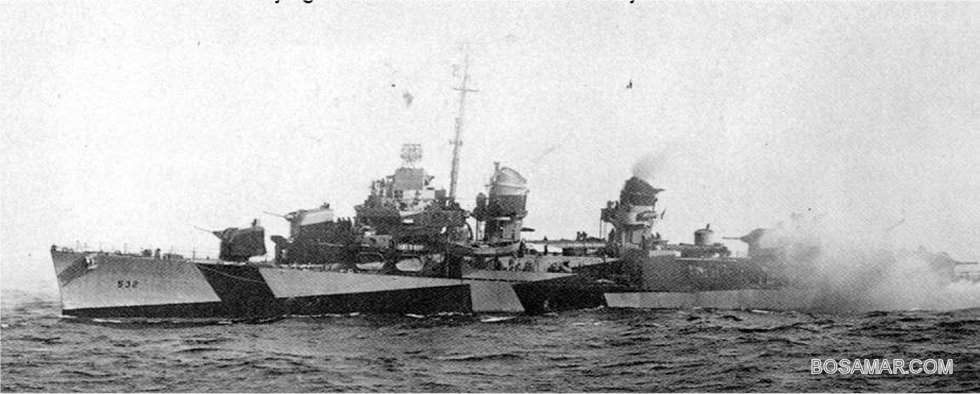
U.S. Navy Photograph
FLETCHER Class destroyer USS HEERMANN (DD 532) at Samar
0749 At a range of 17,000 yards, BB HARUNA fires on an American "destroyer" to starboard.
A/C This "destroyer" was one of the FLETCHERs or possibly DE ROBERTS.
0750 TBS - v Taffy 3, "ALL SMALL BOYS GO IN AND LAUNCH TORPEDO ATTACK."
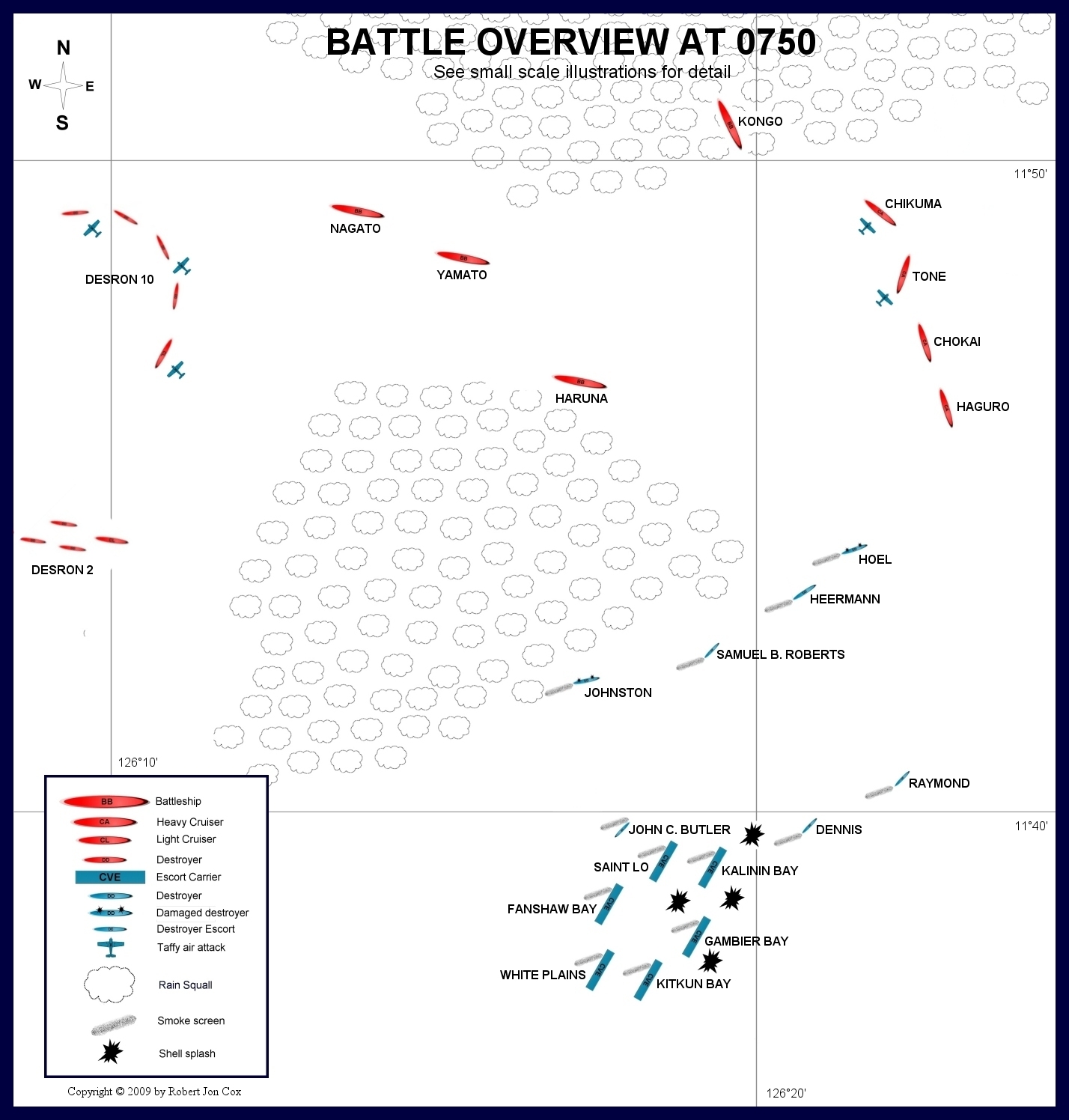
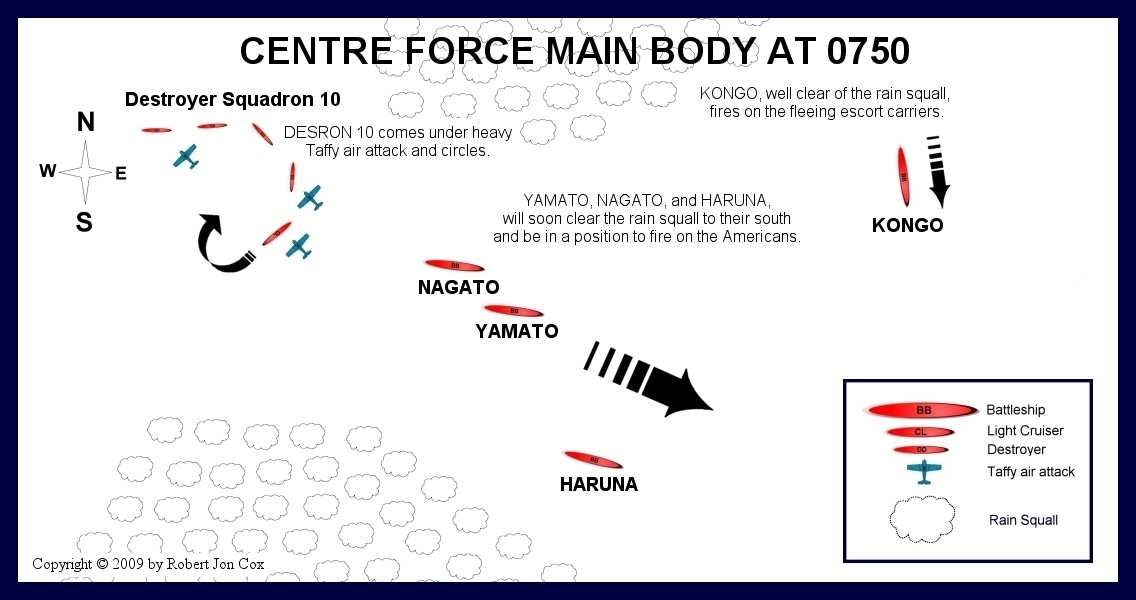
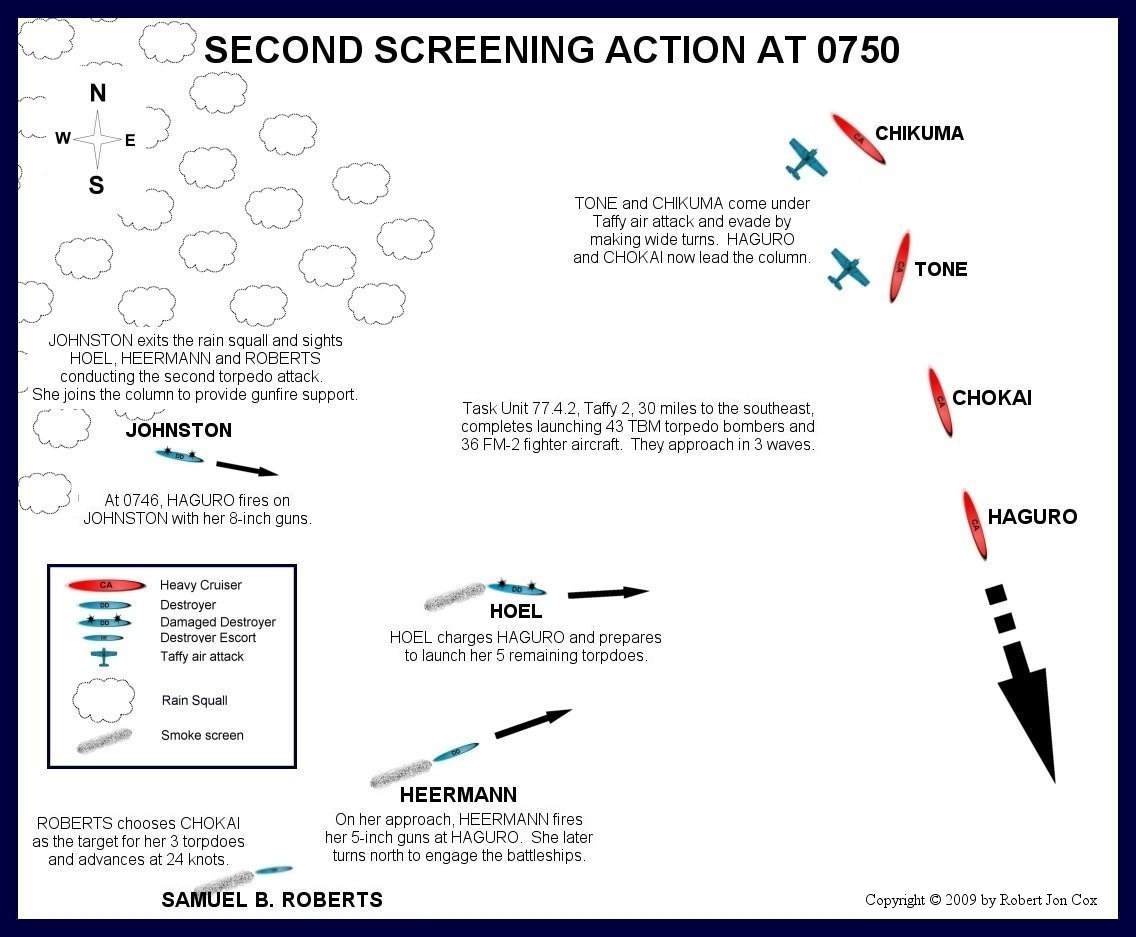
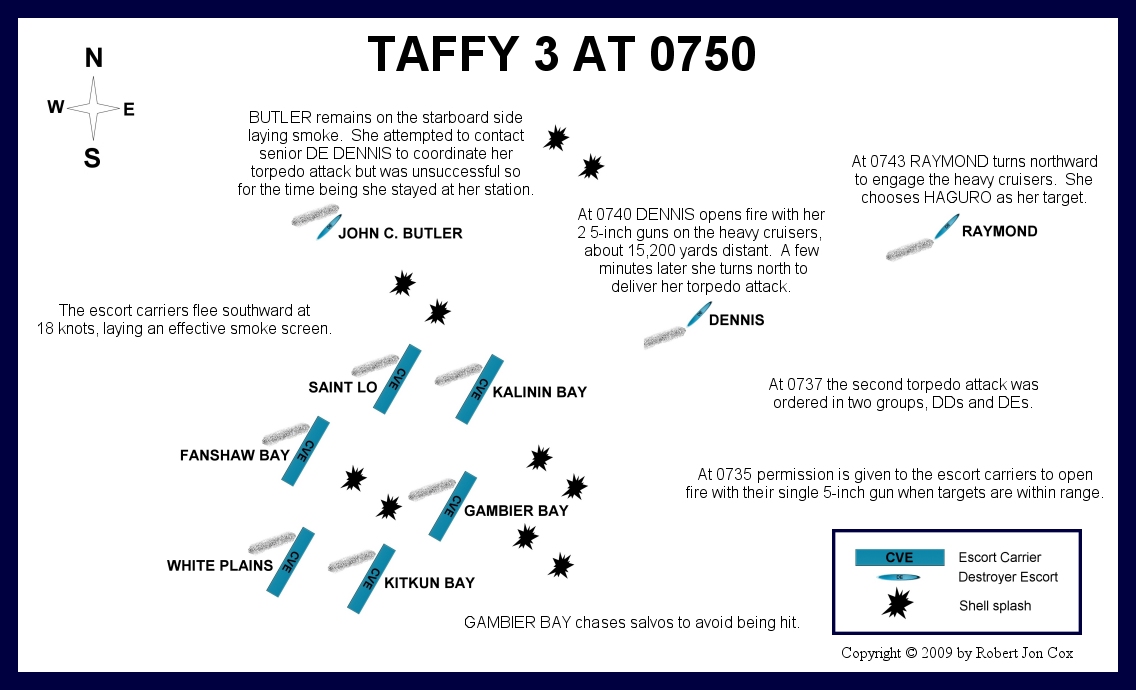
0750 Not satisfied with the progress of second torpedo attack by the escorts, RADM Sprague orders "EXECUTE".
0750 Destroyer JOHNSTON exits the rain squall and sights destroyers HOEL, HEERMANN, and DE ROBERTS conducting the second torpedo attack on an opposite course. Having expended her torpedoes and also having taken a large amount of punishment, DD JOHNSTON joins Taffy III's other two destroyers and DE ROBERTS’ column to provide gunfire support. Due to her extensive damage, DD JOHNSTON’s three aft 5-inch guns must be operated in manual mode.
|
0750 Destroyer Escort DENNIS receives word for the DEs to conduct a separate torpedo attack. She turns northwest and approaches the heavy cruiser column. 0750 Escort Carrier KALININ BAY is hit by the first of several 8-inch shells. More 8-inch shells follow, doing a considerable amount of damage. A/C The Japanese mistakenly used armor piercing shells against the thin-hulled American ships. Most shells passed through the thin-hulled ships without exploding. Had they used high-capacity explosive shells, they may have sunk more ships, and most certainly would have caused more damage and personnel casualties. During the period 0738 to 0750 many salvo splashes were observed on all sides of the ST LO, several not more than 50 yards away. It was reported that there was another CA (heavy cruiser) and several DD (destroyers) moving up to a position off the starboard quarter. However, no salvoes were observed from this side at this time. 0750 Orders are received aboard DE DENNIS to make a torpedo attack with the other destroyer escorts. |
LT Charles R. Ellwood, USNR At first the Jap destroyers seemed to be maneuvering wildly in every direction and finally got into several columns. After several runs I heard DEXTER and CATNIP skippers preparing for their torpedo and bombing attacks. By this time our fighters had separated after their repeated dives and recoveries into the clouds. I paralleled the Jap disposition on the port side in effort to get up front and be of some use on the torpedo and bombing runs. I found some torpedo bombers making bombing runs on three cruisers (in column), and started making strafing runs on the last one which all of the attacks seemed to be concentrated. During these runs I observed only one bombing hit which exploded on the bow and seemed to knock out all of the forward batteries. My guns were all firing intermittently so that I had to charge them after each run. Finally I had but one gun firing, and only forty gallons of gasoline so I departed for the beach. The amount of AA had decreased to where there was only occasional bursts during my last few runs. |
A/C The nearest Japanese warship to DENNIS was a heavy cruiser, about 18,000 yards distant. DENNIS began her approach on course 310° T, speed 22 knots, firing her two 5-inch guns as targets of opportunity presented themselves through the heavy smoke and rain.
0750 Destroyer Squadron TEN, CL YAHAGI and her four destroyers, circle under heavy air attack.
0751 TBS - Taffy 2 v FAMOUS, "AFFIRMATIVE. WE WILL LAUNCH THEM AS SOON AS WE GET INTO THE WIND. WE HAVE TWO AVENGER WITH FISH. WE WILL LAUNCH THEM IN ABOUT TWO MINUTES." .... v Taffy 2, "ROGER OUT."
0751 As the distance between the American screening ships and Battleship Division One decreased, BB YAMATO opens fire with her secondary battery at a "cruiser" at 11,500 yards.
A/C Visibility was still very poor considering the relatively short ranges. The small American warships were constantly driving in and out of the smoke and pall. The warship being shot at by YAMATO was either HOEL or HEERMANN.
EVENT Escort Carrier GAMBIER BAY launches her last plane, without a pilot.
| EVENT Destroyer HOEL, capable of making just over half of her original maximum speed, approaches Cruiser Division 5 and fires her five remaining torpedoes at CA HAGURO. The heavy cruiser is hit by one of DD HOEL’s torpedoes, greatly contributing to the defense of the escort carriers.
EVENT After expending her last torpedoes, DD HOEL is slowed by battle damage. Under limited propulsion she attempts to retire toward the escort carriers in the middle of the Japanese "box". |
LT Maurice 'Fred' Green, USN "With our ten fish fired we decided it was time to get the hell out of there...This proved impossible because we were boxed in on all sides by enemy capital ships. We fishtailed and chased salvos and made all possible speed on one engine which enabled us to continue to remain afloat... The Jap battleships were 8000 yards on the port beam. We had heavy cruisers 7000 yards on the starboard quarter and we had only two guns left to fire. They were forward which made if difficult to continue firing while attempting a retirement. These two guns must have expended 250 or 300 rounds each..." |
EVENT Restrained by battleships NAGATO, KONGŌ, and HARUNA from the rear, heavy cruisers on her left flank and destroyers on the right, DD HOEL has nowhere to go and is hit repeatedly with 16-inch, 14-inch, 8-inch, and 5-inch shells.
|
A/C HOEL was in a tight entanglement. Her speed was limited to a mere 17 knots by this time, no match for the Japanese warships. Now flanked on three sides, she met her demise. EVENT Struck by over 40 shells, DD HOEL’s engine room is soon flooded and she lists 20 degrees to port. Defiantly her two operational guns remain in action against her aggressors, firing over 250 rounds each. 0752 Destroyer Escort DENNIS operates independently and approaches the heavy cruiser column dodging salvos on her approach. |
Action Report “Immediately after launching this attack, hits were received to the after fireroom followed by a direct hit on the after turbine causing the loss of the port engine. The rudder jammed right while turning away from the torpedo attack, due to another hit aft causing the loss of power to the after guns and steering aft, and this vessel turned slowly to the right heading for the battleship at which the torpedoes had been launched. Shifted to hand steering in about two minutes using the steering engine room trick wheel controlled by the bridge pointer.” |
0752 Japanese submarine I-56 sights the escort carriers of Taffy I and chooses CVE SANTEE as her target. A spread of torpedoes are launched, one of which strikes the starboard side near the aft elevator. Hull plates buckled and the ship takes on enough water to cause a 6-degree list. The submarine is pursued by DD TRATHEN with a depth charge attack without results.
EVENT Destroyer HEERMANN, the fittest of the destroyers, engages CA HAGURO and fires 125 5-inch shells on her approach.
|
EVENT Next in line, DE ROBERTS charges CA CHŌKAI at flank bell, 24 knots, laying a dense smoke screen as she goes. On her approach she passes DD JOHNSTON retiring in the opposite direction. An enemy shell, intended for DD JOHNSTON, severs DE ROBERTS’ radio mast antenna which drops onto her sole torpedo tube mount, temporarily placing it out of commission. EVENT Battleship KONGŌ shifts her fire to DD HEERMANN; 14-inch splashes land all around her sending walls of water cascading over her bridge. Behind BB KONGŌ, battleships' HARUNA, NAGATO and mammoth YAMATO race forward. Destroyer HEERMANN turns to engage the battleships. She exchanges fire with the big ships without being hit. A/C There were so many close-aboard near misses on HEERMANN, CDR Hathaway was having trouble seeing over the water geysers which were covering the entire bridge. HEERMANN was likely the only destroyer to have ever engaged four battleships singlehandedly and survived. |
LCDR Robert W. Copeland, USNR Commanding Officer USS SAMUEL B. ROBERTS (DE-413)
|
Her success could be attributed to the confusion of the battle, the smoke screen, rain squalls, her speed, and low silhouette. Most certainly the battleships did not feel threatened by her, and most likely ignored her. They were set on searching for bigger game.
EVENT Presenting a low silhouette, DE ROBERTS is able to approach to within 4,000 yards of the Japanese warships unseen. She recovers from the mast and torpedo tube mount damage, fires her three torpedoes, reverses course, and heads back toward the escort carriers at an emergency flank bell.
A/C Realizing his time under the Japanese large caliber guns was suicidal, LCDR Copeland ordered his engine room to ignore propulsion limits on the journey back to the escort carriers. Safety valves were secured, allowing steam pressure to rise to 670 pounds in a plant designed for a maximum of 440. Shaft rpm rose to 477 on shafts designed for 420. This added push enabled ROBERTS to obtain a speed of 28 and one-half knots.
| A/C The three American screening ships fired a total of fifteen torpedoes at the advancing Japanese during this phase of the screening action. Two of the ships, HOEL and ROBERTS, greatly contributed to the defense of the escort carriers, each hitting an enemy heavy cruiser with their torpedo attack.
EVENT Heavy cruiser CHŌKAI is hit aft by at least one of DE ROBERTS' torpedoes and she falls out of formation. 0754 Attaining a suitable firing position on the Japanese heavy cruiser column, DD HEERMANN fires seven torpedoes at CA HAGURO. Nine thousand yards distant, and moving at 25 knots, the Japanese ship evades all seven torpedoes. 0754 TBS - v Taffy 3, "ALL CARRIERS MAKE SMOKE." |
USS RAYMOND (DE-341) On the run in for this torpedo attack we were underfire from the enemy cruiser and numerous straddles were obtained by them on us. Just after we fired our torpedoes and before we changed course and returned to the formation, the commanding officer observed a destroyer escort, which appeared to be the ROBERTS, on our starboard beam under heavy fire from the enemy. The ROBERTS was firing rapid fire from her 5" guns and she appeared to be taking direct hits from the enemy. A curtain of flashes was observed surrounding this vessel and when we changed course to return to formation, we could no longer locate the ROBERTS. |
0754 TBS - v FIGLEAF, "TORPEDOES COMING TOWARD CARRIER GROUP ON OUR PORT SIDE." .... v FIGLEAF.
EVENT Shortly after firing her torpedoes, DD HEERMANN sighted the battleships approaching from northward, course 350° T. She turns to port and proceeds to engage battleships KONGŌ and HARUNA, about 9,000 yards distant.
0755 Heavy cruiser HAGURO concentrates on DE RAYMOND and puts a salvo 200 yards astern of her.
0755 Destroyer HEERMANN opens fire with her 5-inch guns on BB HARUNA.
0756 Destroyer escort RAYMOND, on the port side of the CVE formation, approaches CA HAGURO, fires her three torpedoes from 10,000 yards and misses. Heavy cruiser HAGURO returns fire, shooting fifteen 8-inch volleys at the small destroyer escort. All miss. Having expended all of her torpedoes, DE RAYMOND reverses course and retires towards the escort carriers.
A/C In his Action Report, LCDR Beyer stated, "...The target at this particular time was making an effort to close the formation; also to outflank the formation on the port side. The DRT tracing of this action indicates that after we fired our torpedoes evasive action was taken by the enemy cruiser. This evasive action succeeded in closing the range at least 1,000 additional yards and made conditions more favorable for our torpedo attack. Several observers stated that we hit this cruiser, however, visibility was so reduced that there is uncertainty as to who may have hit the cruiser."
|
|||||||||||||||||||||||||||||||||||||
| Results of second screening action | |||||||||||||||||||||||||||||||||||||
0756 An aircraft from ST LO’s Composite Squadron VC-65 verified the composition of Centre Force as consisting of, "...four BB (battleships), eight CA (heavy cruisers) and CL (light cruisers) and many DD (destroyers)."
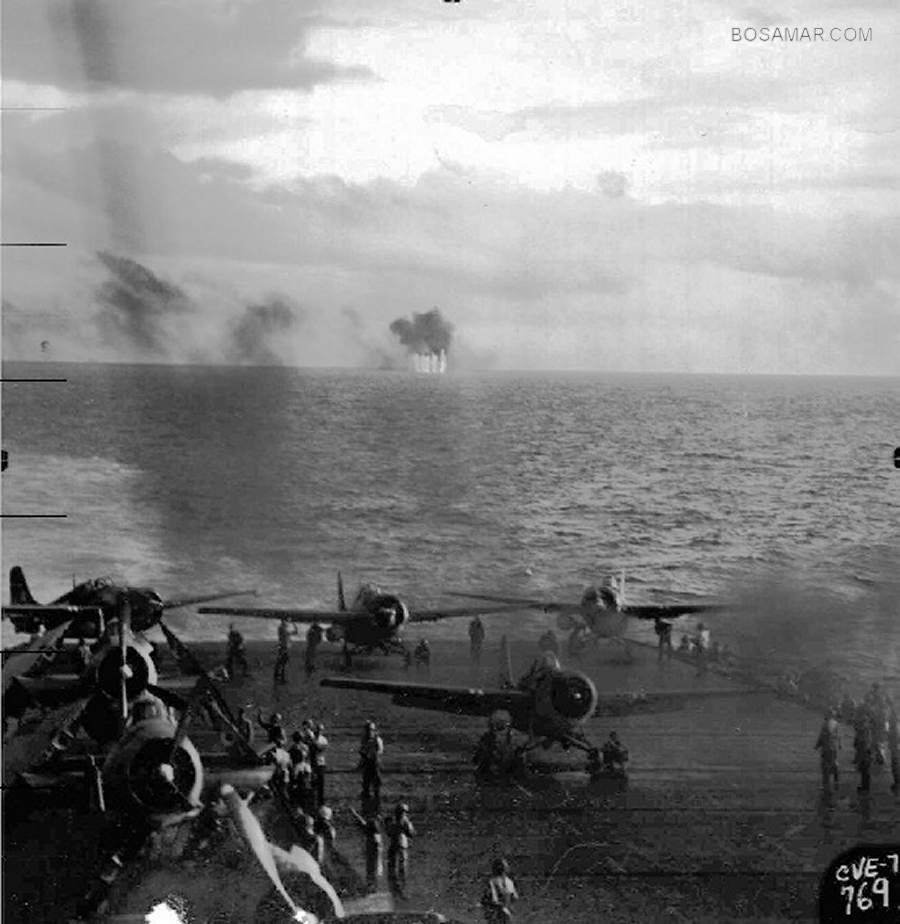
U.S. Navy Photograph
Battle scene from USS KITKUN BAY (CVE 71)
0758 Aboard CVE KITKUN BAY, three destroyers, thought hostile, are reported off the port bow, bearing 147° T, distance 20,000 yards. Their appearance causes great concern until they are identified as friendly.
A/C The destroyers sighted by CVE KITKUN BAY were Taffy II's HAGGARD, HAILEY and FRANKS. They were operating in the rear of their six escort carriers, guarding Taffy II's back door.
0758 Escort carrier SANTEE of Taffy I reports she has regained steering control after the submarine attack. She is able to make 16.5 knots.
|
0758 Destroyer JOHNSTON continues to effectively engage the heavy cruisers. Heavy cruiser TONE fires on DD JOHNSTON and logs the action in her deck log as "fired on heavy cruiser." 0759 At 22 knots, her maximum speed, DE DENNIS approaches to within four miles of the heavy cruiser column. 8,000 yards distant, heavy cruisers HAGURO, TONE, CHŌKAI, and CHIKUMA approach. Destroyer escort DENNIS chooses the second heavy cruiser in line, CA TONE, as her target and fires her three torpedoes. They all run hot, straight and normal but all miss. Destroyer escort DENNIS then turns southwest and opens fire on another cruiser with her number 2 5-inch gun. A/C The "Little Wolves" had now executed the secondary torpedo attack ordered earlier by RADM Sprague. Although DENNIS and RAYMOND failed to score any hits during their torpedo attacks, they helped significantly by forcing HAGURO and TONE to take their focus away from the escort carriers. |
CTU 77.4.3/COMCARDIV 25 Action Report Now it became apparent that the enemy had split up and was advancing two heavy cruisers upon our port quarter to encircle our disposition and cut off our retreat. These two enemy cruisers eventually succeeded in advancing almost abeam of us and closing range at will. Eight and five inch salvos from this advanced wing were delivered from ranges as low as 10,000 yards and resulted in many straddles and many hits. All available aircraft were diverted to this threat and bomb hits were obtained. Our 5"-38 return fire was reaching these heavy cruisers and some hits were being scored. But notwithstanding our desperate efforts, the CA fire was practically continuous and so effective that eventual destruction of all of our ships seemed inevitable. |
A/C DENNIS’ torpedo firing course was 270° T. The second torpedo was fired 20 seconds after the first, and the third torpedo five seconds after the second. In his Action Report, LCDR Hansen wrote: "...At 0759, this vessel delivered a torpedo attack, on an enemy cruiser, class undetermined; however, due the chemical and stack smoke, and smoke of gunfire, the bridge personnel were unable to observe the effects of this attack. Men on the signal bridge, after 5"/38 gun, and depth charge racks claim to have followed the torpedo tracks in to the cruiser and to have observed one hit on the bow of the cruiser, causing a column of water to rise about 40 feet into the air. The target was at the time under torpedo attack by other DE's."
0759 Heavy cruiser TONE, second in line in the advancing cruiser column is hit forward by taffy aircraft. The resulting fires cause her to momentarily drop out of line. She brings the fires under control and rejoins the cruiser column behind CA CHIKUMA with little loss of ground.
0758 The fourth Japanese kamikaze aircraft from the previous attack on Taffy I returns and chooses CVE SUWANEE as her target. The Zeke 52 makes a 45-degree dive and crashes into the flight deck 40 feet forward of the aft elevator, ripping a ten-foot hole in the deck. Its bomb continues through the flight deck and explodes in the hangar deck creating a 20-foot hole. Steering in temporarily lost and damage control efforts save the ship.
|
0800 Destroyer HEERMANN at 4,400 yards, fires her remaining three torpedoes at BB HARUNA. The torpedoes miss BB HARUNA, but BB YAMATO, in the line of fire, is forced to reverse course and run north for 10 miles to avoid DD HEERMANN's torpedo tracks. A/C This action was perhaps the most fortunate event of the entire battle. It placed BB YAMATO's big guns, along with VADM Kurita's command and control, out of communication with the forward elements of Centre Force for the remainder of the action. From the Japanese point of view, YAMATO’s performance in the Battle Off Samar was disappointing. Her large 18.1-inch guns, the largest in the world, failed to sink any ships outright. |
CDR Amos T. Hathaway, USN Commanding Officer USS HEERMANN (DD-532)
|
0800 TBS - Taffy 33 v JUGGERNAUGHT, "MY FISH ARE OFF."
EVENT With all ten of her torpedoes expended, DD HEERMANN reverses course and heads back to the starboard quarter of the escort carrier formation to lay more smoke.
EVENT Taffy III's Avengers hit CA HAGURO and put her #2 turret out of action. Harried and damaged, heavy cruisers HAGURO and CHŌKAI of Cruiser Division Five fall back.
EVENT Heavy cruisers CHIKUMA and TONE, the most fit of the remaining ships of Cruiser Division Seven, now take the lead and concentrate their fire on the fleeing escort carriers.